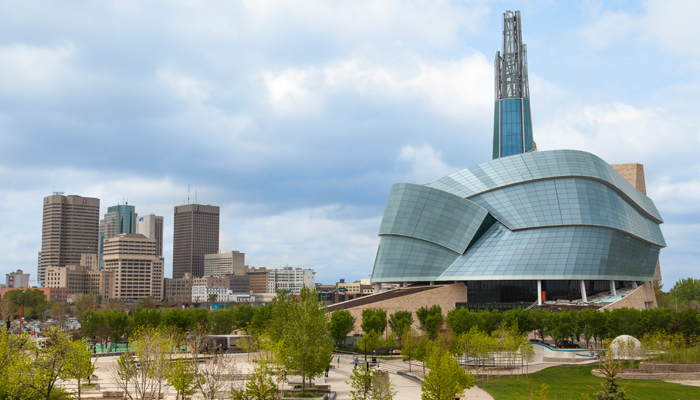
Canadian Museum for Human Rights
On the opening of the Canadian Museum for Human Rights
A message from Dr. David Barnard, president of the University of Manitoba
Friends and colleagues, it is my pleasure and honour to offer congratulations to all those involved with the Canadian Museum for Human Rights (CMHR) on the day of the grand celebration of its opening here in Winnipeg.
After more than a decade of planning and development, the CMHR today marks the beginning of a new era in public education about and recognition of the importance of human rights issues throughout the world.
It is gratifying to see the Canadian Museum for Human Rights open in Winnipeg. Much hard work and planning went into its creation, from the wonderful, award-winning building that is an example of striking and breathtaking architecture, to its dramatic content that will inspire and educate us all.
The University of Manitoba has been an active partner and integral part of the dialogue leading to the opening of the CMHR, with contributions from faculty, staff and students across many disciplines.
At the University of Manitoba, we describe trailblazers and visionaries as the people who see beyond obstacles to build a better world. The Canadian Museum for Human Rights is the product of hard work of people like our alumni Gail Asper, Moe Levy and the late Israel and Babs Asper. It has launched under the direction of pioneers such as Stuart Murray and all the Friends of the Canadian Museum for Human Rights. Their shared commitment has allowed us to see this project to completion.
Human rights is one of the areas of research strengths we have identified at the University of Manitoba. In addition to expertise residing in 12 faculties and as many as 150 researchers, we are home to three centres devoted to issues of human rights research: the Centre for Human Rights Research, the Mauro Centre for Peace and Justice, and the National Research Centre for Truth and Reconciliation.
Manitoba’s position as a hub of human rights research in Canada will be strengthened further by our development of a Master of Human Rights (MHR) program here at the University of Manitoba. It would be broadly interdisciplinary, branching into the social sciences, sciences and humanities, taking advantage of expertise in the university’s professional schools, including medicine, social work education, nursing and law.
The University of Manitoba is committed to an enduring partnership with the Canadian Museum for Human Rights; one that establishes Manitoba as the global capital for learning and studies in fields related to human rights, towards the betterment of humankind.
Again, I offer congratulations to those involved with the Canadian Museum for Human Rights as it begins its voyage of discovery and illumination.







How unfortunate that an academic would praise those who elevated the suffering of one community above all others and used a national museum to do that in. However pretty the CMHR may be as a building its contents will remain controversial and divisive until this founding flaw has been undone, as it will be, sooner or later, because this is a national museum and not a private one.
I believe that the way we try to construct the World it is very important not only for our generations but for the power and joy that God gave us. We want to promote respect and freedoms of speech. That is why I came to Winnipeg. After my opinion we are born free and equal in rights. All people are equal and are entitled without discrimination to equal protection of the law. Unfortunately we live hard times where people ignore the rules and is beyond our power to change the World but for sure this tremendous work (Canadian Museum for Human Rights) should be something that will inspire us very much. I just wait to see it!